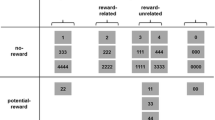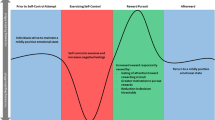Abstract
In order to test the homogeneity assumption, which states that overt and covert behaviors obey the same laws, four subjects who reported covert smoking urges prior to engaging in the consummatory act of smoking were recruited to self-monitor urges and smoking behavior. The data from two subjects in Experiment 1 supported the view that urges are not artifactual byproducts of consummatory response occurrence, because frequencies of urges and smoking behavior were uncorrelated when subjects were asked not to smoke on alternate days. Stimulus control of urges was demonstrated in Experiment 2; urges were more likely in a situation that was associated with smoking than in a nonsmoking situation. This finding is consistent with the hypothesis that urges are reinforced by the associated consummatory act.
Similar content being viewed by others
References
ACKERMAN, P. D. 1972. Extinction of covert impulses through elimination of consummatory events. The Psychological Record, 22, 477–485.
ACKERMAN, P. D. 1973. Formulations regarding an experimental analysis of covert impulse and depression responses as mediators of consummatory S-R sequences. The Psychological Record, 23, 477–486.
HOMME, L. E. 1965. Perspectives in psychology: XXIV. Control of coverants, the operants of the mind. The Psychological Record, 15, 501–511.
KANTOR, J. R. 1926. Principles of psychology. Vol. II. Granville, Ohio: Principia Press.
MAHONEY, M. J. 1974. Cognition and behavior modification. Cambridge, Mass.: Ballinger Publishing Co.
MAHONEY, M. J., THORESEN, C. E., & DANAHER, B. G. 1972. Covert behavior modification: An experimental analogue. Journal of Behavior Therapy and Experimental Psychiatry, 3, 7–14.
McFALL, R. M., & HAMMEN, C. L. 1971. Motivation, structure, and self-monitoring: Role of nonspecific factors in smoking reduction. Journal of Consulting and Clinical Psychology, 37, 80–86.
REYNOLDS, G. S. 1968. A primer of operant conditioning. Atlanta: Scott, Foresman.
SKINNER, B. F. 1953. Science and human behavior. New York: Free Press.
ZIMMERMAN, J. 1975. If it’s what’s inside that counts, why not count it? I: Self-recording of feelings and treatment by “self-implosion”. The Psychological Record, 25, 3–16.
Author information
Authors and Affiliations
Rights and permissions
About this article
Cite this article
Smith, G.S., Delprato, D.J. Stimulus Control of Covert Behaviors (Urges). Psychol Rec 26, 461–466 (1976). https://doi.org/10.1007/BF03394411
Published:
Issue Date:
DOI: https://doi.org/10.1007/BF03394411




